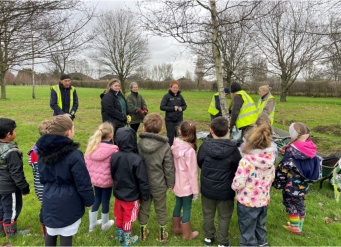 The Federation of Trosnant schools are participating in creating a Mini Miyawaki method forest. This method is an effective way to create a dense forest by using native trees such as crab apples, oak, wild cherry, black popular, elder, hazel and silver birch.
The Federation of Trosnant schools are participating in creating a Mini Miyawaki method forest. This method is an effective way to create a dense forest by using native trees such as crab apples, oak, wild cherry, black popular, elder, hazel and silver birch.
The saplings grown faster as they compete to reach the sun, they also capture more carbon dioxide and create more biodiversity. This then allows the children to be surrounded in nature and to participate in activities such as mindfulness and understanding why trees are so important in our ever changing climate.
The children at Trosnant Infant and Junior school planted a total of 1000 trees with every child having the chance to plant at least one tree (if not more). The project was supported by Hampshire Forest Partnership who supplied the school with all the trees and prepared the land. The school also had help from Havant tree wardens who assisted the children when planting.
The planting took place over two days and was well received with enthusiasm from the children and adults.
The trees are settling in well and will be looked after by the children and forest school practitioner.
Akira Miyawaki -1928–2021was a Japanese botanist and an expert in plant ecology who specialized in seeds and natural forests. He was a specialist in natural vegetation restoration of degraded land. He observed trees that traditionally grew around temples, shrines, and cemeteries in Japan, such as Japanese chestnut trees He believed that they were relicts of the primary forest. He noted that trees such as Japanese cedar, cypress and larch pine, supposedly native to Japan, had been introduced into Japan over centuries by foresters to produce timber. Miyawaki reflected on the consequences of the change in composition and structure of most Japanese forests, most of which do not contain solely their original natural vegetation.